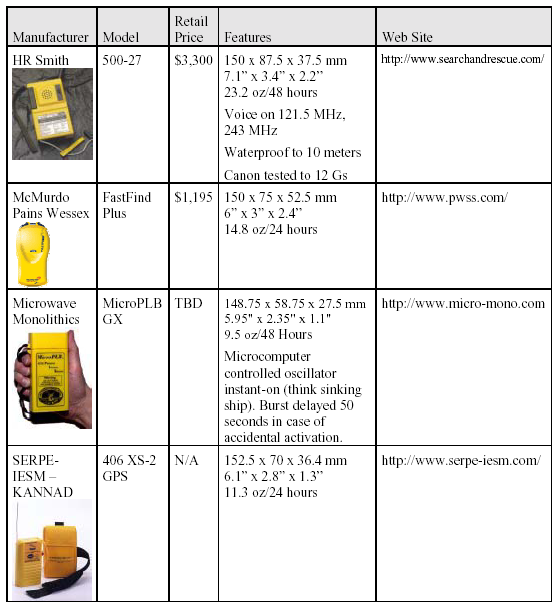Personal locator beacons
Occasionally we end up in places where we might have a life-threatening problem and really need to be rescued. This may happen if we are involved in a plane crash, a boat accident, a car accident in the desert, a hiking accident, or any number of other rare and unfortunate situations where we need serious emergency help.
In some places you can use your trusty cell phone and simply call out for help. During one of the U.S.’s smaller wars in the Caribbean, a few of our troops got trapped with no means of communication (something to do with every service having different radios operating on different frequencies). One of the soldiers had his cell phone and called his mother, who called Washington, who called someone local, who rescued them. Amusing as this is, if true, it is equally true that in many places there is simply no cell phone coverage. What then? One possibility is a satellite phone, but many of these are the size of a laptop computer, and some are relatively delicate.
An alternative is to have a personal locator beacon, aka a PLB. These are individually registered and astonishingly small devices that emit a signal on 406 MHz that is picked up by COSPAS-SARSAT satellites. The PLBs we recommend contain a built-in GPS system, so the satellites’ receiving stations quickly – if you are between the Arctic Circle and the Antarctic Circle, the satellite geometry is such that the very first GPS location burst transmission should be captured – know three things: To whom the PLB belongs, where the PLB is (give or take 100 meters), and that you are actively (you have to take a series of steps like pulling a tab and pushing a button to activate the PLB) indicating that you are in trouble. At this point an appropriate sea-air-land rescue can be launched.
The signal will be transmitted for a nominal 24 or 48 hours, depending on the device. Frankly, if search and rescue hasn’t launched within three hours of the PLB being activated, something is seriously wrong! In addition, according to a study done by the U.S. Coast Guard using Microwave Monolithics PLBs, it appears that once a signal is picked up (usually within 60 seconds of device activation), it is passed off to the appropriate authority immediately, but not reported again. This means that once the distress signal has been picked up, the PLBB has largely done its job. However, the signal additionally sent on 121.5 can still be used for location by triangulation, or for voice transmission if included.
The devices, by the way, should not have been damaged by the incident. They are all water resistant to at least one meter and dropped tested on all sides from at least one meter.
PLBs should be used when you might otherwise die if not rescued soon. PLBs should not be activated if no lives are at stake. A rescue effort is always very expensive and puts the rescuers at risk. If it is felt that the use of the PLB was frivolous, expect at the very least to get a VERY large bill to cover the cost of the rescue effort!
As noted above, the first distinguishing characteristic among PLBs is whether or not they include built-in GPS. The cost – those without voice communications are around $1,200 – is low enough that it makes no sense for the corporate user to consider a system without GPS, particularly since GPS narrows your location from 1.3 kilometers without GPS to 100 meters with GPS! While PLBs also transmit on 121.5 MHz, (a common aviation frequency for which there is readily available triangulation equipment), if I am in trouble I want my rescuers to have the most precise location possible, which means GPS.
The second distinguishing characteristic is whether you have voice communications (available on 121.5 and 243 MHz). Voice communication is obviously desirable in many circumstances, particularly if someone is conscious and able to speak, but pushes the cost of the HR Smith model, which comes with voice communications built-in (it is also water resistant to 10 meters, and canon tested to 12 Gs, hinting that the unit has been designed to military specifications) to $3,300. While this is certainly not an unreasonable amount to have with your $100,000,000 executive in his $20,000,000 aircraft when it crashes in the middle of nowhere, you should not feel unprotected with a PLB lacking voice communications.
We looked at four devices, all of which we would comfortably use, and all of which we are comfortable in recommending for your consideration. We have listed these in alphabetical order by company in the chart below.
The bottom line is that in many situations a PLB is very appropriate to have in your pocket or bag case of emergencies. If we have a detail where a PLB might be appropriate, would I fight for to have one? Of course. If you have an emergency and someone will die because you don’t have one, would it be worth way more than its cost to you? Absolutely!!!


